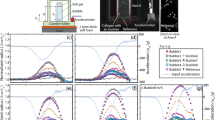Abstract
The mechanical response of living tissue is important to understanding the injury-risk associated with impact events. Often, ballistic gelatin or synthetic materials are developed to serve as tissue surrogates in mechanical testing. Unfortunately, current materials are not optimal and present several experimental challenges. Bulk measurement techniques, such as compression and shear testing geometries, do not fully represent the stress states and rate of loading experienced in an actual impact event. Indentation testing induces deviatoric stress states as well as strain rates not typically available to bulk measurement equipment. In this work, a ballistic gelatin and two styrene-isoprene triblock copolymer gels are tested and compared using both macroscale and microscale measurements. A methodology is presented to conduct instrumented indentation experiments on materials with a modulus far below 1 MPa. The synthetic triblock copolymer gels were much easier to test than the ballistic gelatin. Compared to ballistic gelatin, both copolymer gels were found to have a greater degree of thermal stability. All of the materials exhibit strain-rate dependence, although the magnitude of dependence was a function of the loading rate and testing method.
Similar content being viewed by others
References
M.L. Fackler, J.A. Malinowski: The wound profile: A visual method for quantifying gunshot wound components. J. Trauma-Injury Infection Crit. Care 25, 522 (1985).
M.L. Fackler, J.S. Surinchak, J.A. Malinowski, R.E. Bowen: Bullet fragmentation: A major cause of tissue disruption. J. Trauma-Injury Infection Crit. Care 24, 35 (1984).
K.E. Simmonds, P. Matic, M. Chase, and A. Leung: 2004 NRL Review.http://www.nrl.navy.mil.
P.J. Biermann, E.M. Ward, R.P. Cain, B. Carkhuff, A.C. Merkle, J.C. Roberts: Development of a physical human surrogate torso model for ballistic impact and blast. J. Adv. Mater. 38, 3 (2006).
L.G. Hole: Anatomical models based on gelatin and the influence of garmets on impact damage. (Shoe & Allied Trade Research Association, Satra House, Kettering, North Hamptonshire, UK, 1980).
Data Book on Mechanical Properties of Living Cells, Tissues, and Organs, edited by H. Abe, K. Hayashi, and M. Sato (Springer-Verlag, Tokyo, Japan, 1996).
N.C. Nicholas, J.R. Welsch: Ballistic Gelatin (Institute for Non-Lethal Defense Technologies Report, Penn State Applied Research Laboratory, Happy Valley, PA, 2004).
A.J. Dzieman: A Provisional Casualty Criteria for Fragments and Projectiles, Edgewood Arsenal Maryland Report #2391 (U.S. Army, Edgewood, MD, 1960).
J.J. Amato, L.J. Billy, R.P. Gruber, N.S. Lawson, N.M. Rich: Vascular injuries: An experimental study of high and low velocity missile wounds. Arch. Surg. 101, 167 (1970).
M.L. Fackler: Wound ballistics: A target for error. Int. Def. Rev. 8, 895 (1988).
T.P. Lodge, K.J. Hanley, B. Pudil, V. Alahapperuma: Phase behavior of block copolymers in a neutral solvent. Macromolecules 36, 816 (2003).
K.J. Hanley, T.P. Lodge, C.I. Huang: Phase behavior of a block copolymer in solvents of varying selectivity. Macromolecules 33, 5918 (2000).
H. Watanabe, S. Kuwahara, T. Kotaka: Rheology of styrene-butadiene-styrene triblock copolymer in n-tetradecane systems. J. Rheol. 28, 393 (1984).
T. Sato, H. Watanabe, K. Osaki: Thermoreversible physical gelation of block copolymers in a selective solvent. Macromolecules 33, 1686 (2000).
J.R. Quintana, E. Diaz, I. Katime: Influence of the copolymer molar mass on the physical gelation of triblock copolymers in a selective solvent of the middle block. Macromolecules 30, 3507 (1997).
P.L. Drzal, K.R. Shull: Origins of mechanical strength and elasticity in thermally reversible acrylic triblock copolymer gels. Macromolecules 36, 2000 (2003).
J.H. Laurer, J.F. Mulling, S.A. Khan, R.J. Spontak, R. Bukovnik: Thermoplastic elastomer gels. I. Effects of composition and processing on morphology and gel behavior. J. Polym. Sci., Part B: Polym. Phys. 36, 2379 (1998).
J.H. Laurer, J.F. Mulling, S.A. Khan, R.J. Spontak, R. Bukovnik: Thermoplastic elastomer gels. II. Effects of composition and temperature on morphology and gel rheology. J. Polym. Sci., Part B: Polym. Phys. 36, 2513 (1998).
W.C. Oliver, G.M. Pharr: An improved technique for determining hardness and elastic modulus using load and displacement sensing indentation experiments. J. Mater. Res. 7, 1564 (1992).
K.L. Johnson: Contact Mechanics (Cambridge University Press, New York, 1985).
I.N. Sneddon: The relation between load and penetration in the axisymmetric Boussinesq problem for a punch of arbitrary profile. Int. J. Eng. Sci. 3, 47 (1965).
M.R. VanLandingham, N.K. Chang, P.L. Drzal, C.C. White, S.H. Chang: Viscoelastic characterization of polymers using instrumented indentation I. Quasi-static testing. J. Polym. Sci., Part B: Polym. Phys. 43, 1794 (2005).
C.C. White, M.R. VanLandingham, P.L. Drzal, N.K. Chang, S.H. Chang: Viscoelastic characterization of polymers using instrumented indentation II. Dynamic testing. J. Polym. Sci., Part B: Polym. Phys. 43, 1812 (2005).
L. Cheng, X. Xia, W. Yu, L.E. Scriven, W.W. Gerberich: Flat-punch indentation of viscoelastic material. J. Polym. Sci., Part B: Polym. Phys. 38, 10 (2000).
M.L. Oyen, R.F. Cook: Load-displacement behavior during sharp indentation of viscous-elastic-plastic materials. J. Mater. Res. 18, 139 (2003).
N.M. Vriend, A.P. Kren: Determination of the viscoelastic properties of elastomeric materials by the dynamic indentation method. Polym. Test. 23, 369 (2004).
A.C. Fischer-Cripps: Multiple-frequency dynamic nanoindentation testing. J. Mater. Res. 19, 2981 (2004).
M.R. VanLandingham, T.F. Juliano, M.J. Hagon: Measuring tip shape for instrumented indentation using atomic force microscopy. Meas. Sci. Technol. 16, 2173 (2005).
E.H. Lee, J.R.M Radok: The contact problem for viscoelastic bodies. Trans. ASME 27, 438 (1960).
T.C.T Ting: The contact stresses between a rigid indenter and a viscoelastic half-space. J. Appl. Mech. 33, 845 (1966).
Engineering with Rubber: How to Design Rubber Components edited by A.N. Gent (Hanser Publishers, New York, 1992).
B.N. Lucas: An experimental investigation of creep and viscoelastic properties using depth-sensing indentation techniques. Ph.D. Dissertation, The University of Tennessee, Knoxville, TN (1997).
N. Conte: Dynamic mechanical characterization of very soft polymeric materials using nanoindentation. Masters Thesis, The University of Tennessee, Knoxville, TN (2002).
Author information
Authors and Affiliations
Corresponding author
Rights and permissions
About this article
Cite this article
Juliano, T.F., Forster, A.M., Drzal, P.L. et al. Multiscale mechanical characterization of biomimetic physically associating gels. Journal of Materials Research 21, 2084–2092 (2006). https://doi.org/10.1557/jmr.2006.0254
Received:
Accepted:
Published:
Issue Date:
DOI: https://doi.org/10.1557/jmr.2006.0254




